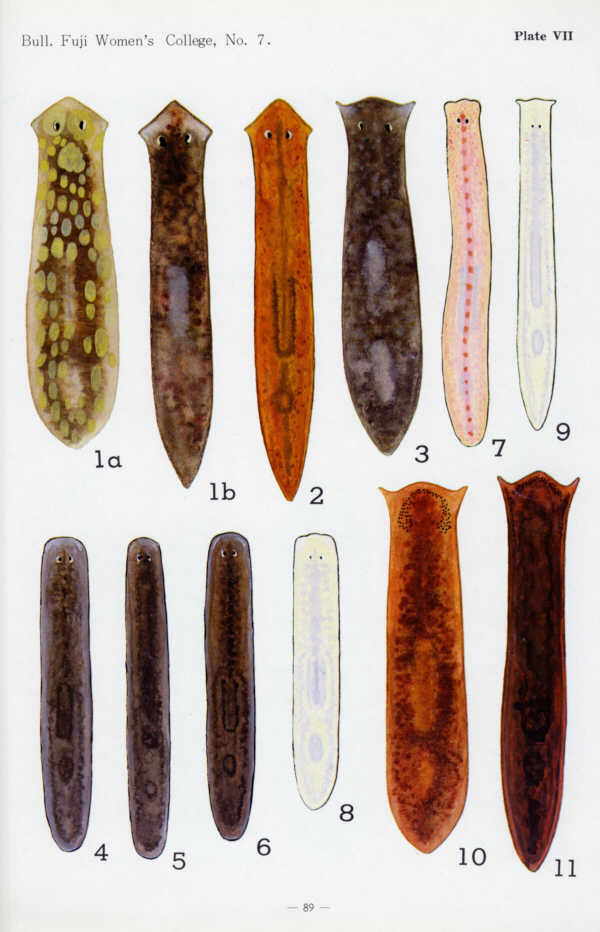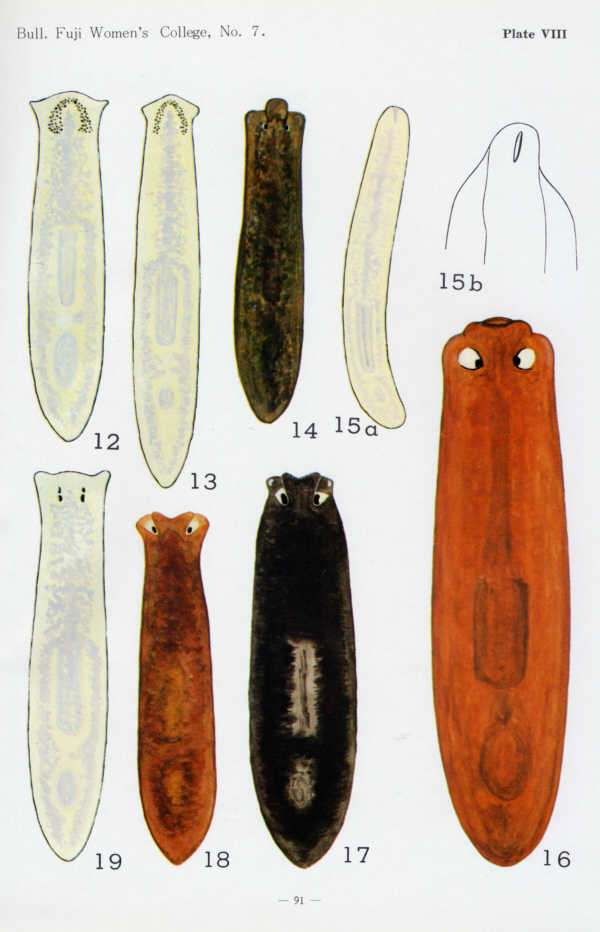
Kawakatsu, 1969: Plate VII
Dugesia japonica: 1a. The Matsumoto stock (sexual race). 1b. The Kyûshû stock (asexual race).
http://www2u.biglobe.ne.jp/~gen-yu/plaj_list_e.html
By Gen-yu SASAKI (gen-yu@mtc.biglobe.ne.jp)
The taxonomy and distributional ecology of Japanese freshwater planarians ("Turbellaria": Seriata: Tricladida) have been studied by Dr. M. Kawakatsu and his team members for the past 50 years. In 1969, he published an illustrated list of this animal group with distribution maps and water color paintings of the 19 known species at that time (2 families and 6 genera; including 2 unidentified species of the genus Sphalloplana).
After the 1970s', 5 native species and 3 exotic species have been described and reported by Kawakatsu and his coauthors from Japan. The taxonomic system from the rank of suborder through infraorder, family, subfamily, genus, and subgenus was revised in 1974.
In the present web article a revised list of all the known species of Japanese freshwater planarians is given with their latest Linnean names and Japanese names (see Notes for the Taxonomic List) in the Roman alphabet (1 suborder, 2 infraorders, 4 families, 2 subfamilies, 8 genera, 1 subgenus, 27 species; including 2 undescribed species). Dr. Kawakatsu's (1969) original 2 color plates are also reproduced herein; no paintings of 8 species described after 1970 are included (see the mark "-" in the Taxonomic List).
In Japan both Japanese and Linnean names of animals (and plants) are employed in usual biology books and encyclopedias. For this custom a complehensive explanation is given in the following English article.
The infraorder Cavernicola Sluys, 1990 (including 1 family and 5 genera), was established in the following publication.
Japanese Freshwater Planarians: Taxonomy("Turbellaria": Seriata: Tricladida): mainly based on Kawakatsu, 1998. | |||||||||||||||||||||||||||||||||||||||||||||||||||||||||||||||||||||||||||||||||||||||||||||||||||||||||||||||||||||||||||||||||||||||||||||||||||||||||||||||||||||||||||||||||||||||||||||||||||||||||||||||||||||||||||||
| |||||||||||||||||||||||||||||||||||||||||||||||||||||||||||||||||||||||||||||||||||||||||||||||||||||||||||||||||||||||||||||||||||||||||||||||||||||||||||||||||||||||||||||||||||||||||||||||||||||||||||||||||||||||||||||
|
In the taxonomic list the figures of 8 species with a mark "-" are not presented in this web article. | |||||||||||||||||||||||||||||||||||||||||||||||||||||||||||||||||||||||||||||||||||||||||||||||||||||||||||||||||||||||||||||||||||||||||||||||||||||||||||||||||||||||||||||||||||||||||||||||||||||||||||||||||||||||||||||
 |
|
Kawakatsu, 1969: Plate VII Dugesia japonica: 1a. The Matsumoto stock (sexual race). 1b. The Kyûshû stock (asexual race). |
 |
|
Kawakatsu, 1969: Plate VIII Sphalloplana sp. 2: 15a. The Himeji stock. 15b. Adhesive organ (an enlarged, ventral view of the head). |
Order and Suborders of Japanese Planarians ("Turbellaria")So-called "planarians" in a narrow sense indicate macroscopic flatworms in the order Tricladida. In a wide sense, however, that word means a general, collective name of animals in a few orders (and suborders) of the class "Turbellaria". The order Polycladida is a large group of marine planarians. The following tabular list is a summary of the taxa and their numbers listed in a Japanese paper published by Kawakatsu (1998). His list includes flatworms of 8 orders, 20 families, 93 species, and 3 subspecies. According to Dr. Kawakatsu that list was prepared as basic data for the compilation of the Japanese Red Data Book of Endangered Species: The Invertebrates (First Ed., 1991; see the References in the previous section of this web article).
Kawakatsu's (1998) list of "Turbellarians" includes macroscopic, freshwater and terrestrial species and only a single marine triclad, Ectoplana limuli (Ijima et Kaburaki, 1916), an ectoparasitic species of the Japanese helmet crab (Tachypleus tridentatus). This probably results from T. tridentatus approaching beaches at spring tide to lay their eggs in the sand. In this list, Rhodax? sp. in the Cavernicola is placed in the Paludicola. Additionally, the class "Turbellaria" is now considered a non-monophyletic group. | |||||||||||||||||||||||||||||||||||||||||||||||||||||||||||||||||||||||||||||||||||
Sasaki, the compiler of this web article, wishes to express his hearty thanks to Dr. Masaharu Kawakatsu (Sapporo, Japan) for his kind permission for the opening of this home page mainly based upon his papers as well as for his careful reading and suggestions in an early draft. The compiler is also indebted to Dr. Robert W. Mitchell (Bandera, Texas, U.S.A.) for his kind reading and corrections of English usage in the final draft.
This web article was opened in public on May 5, 2001. According to a suggestion of Dr. Kawakatsu, it becomes clear that some additions and corrections to the present article are necessary.
| Maricola: | 2f. 2sf. | 6g. 7spp |
| Paludicola: | 3f. 2sf. | 8g. 27spp. |
| Terricola: | 3f. 3sf. | 7g. 15spp. ( +12 "unidentifiable" spp. including species inquirendae) |
| Cavernicola: | 1f. | 1g. 1sp. |
| (f = family; sf = subfamily; g = genus) | ||